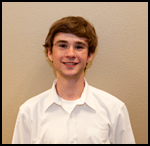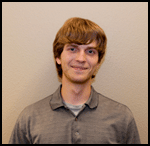Matthew Feddersen & Blake Marggraff's ISEF Experiments with X-rays
Science (and Radiation Experiments) as a Summer Hobby
by Matthew Feddersen
Blake and I have always been interested in science. Not just learning about physics and biology and electricity, but actually experimenting with concepts from those fields. We spent most of our free weekends during school performing experiments and learning as much as we could from random scientific areas. A lot of our experiments involved chemistry and physics; almost every one involved an explosion of some sort. That's not to say that we weren't safe scientists; we were more like Mythbusters—we wanted to test and understand scientific ideas, as long as there were explosions involved.
We didn't see our experiments as official "scientific" experiments. From our perspective, they were more fun than that. When something didn't work as planned, we tried again, making small changes here and there to achieve the desired result. And when everything worked spectacularly, we repeated the process. Only bigger and louder. In a sense, that's science already, but to us it was simply a way to find fun and excitement.
We performed weekend experiments throughout high school, always thinking of new topics to explore and investigate. During the summer of senior year, we decided to get serious about radiation. We were going to mess around with uranium, X-rays, and Geiger counters. Both Blake and I had experience with radiation and knew about the concepts (we both had the Nuclear Science merit badge from Boy Scouts), but we wanted to learn more interesting aspects of radiation than what we already knew, without putting ourselves at (too much) risk. In the name of safety, Blake bought 50 pounds of lead from the internet, which would eventually serve as a shield for our experiments.
In our research for types of shielding, we found warnings about secondary radiation. Certain materials, instead of stopping radiation, would either let the radiation pass through or produce a second form of radiation. This second radiation coming from the shield could damage anyone almost as effectively as the initial radiation. We made sure to stick with lead, which is the industry standard (as well as concrete), for our shielding. We didn't want any secondary radiation. With all this information, we started our basic radiation experiments, testing the attenuation coefficients of lead, glass, and paraffin with gamma radiation coming from a uranium source. That was the summer of our senior year.
School came around, and the experiments slowed down, a lot. We had college applications to fill out, due dates to make, and homework above all else. Classes were difficult, but we managed just like everybody else. One of our favorite classes was accelerated biotechnology, where the atmosphere was easygoing and free, and homework wasn't given priority. An entire class could be devoted to discussing a current event, bioethics, or certain scientific phenomenon, especially if a student brought up the topic.
It was in this class that an idea for a new experiment was born. During class one day, Blake drew out for me a possible setup for his new idea: Use a metal to produce secondary radiation and test how effectively the secondary radiation could kill cells—cancer cells or otherwise. We started mulling over ways to design this experiment, from using petri dishes to test tubes, yeast cells to bacteria. I ran some calculations based on previous research to determine the exposure ranges for the radiation, as well as the energy ranges on scattered radiation.
We didn't get an opportunity to start experimenting until January (the idea came up around November) when our biotechnology teacher announced that he wanted everyone to create their own science project. Given this opportunity, we dove headfirst into our project, even going so far as to build our own X-ray machine in the classroom. Using a high-voltage power supply and an old vacuum tube, we were able to produce X-rays with the same intensity as dental X-ray machines, which was incredibly exciting to do in a classroom environment. The project took off from there and eventually went to the Intel ISEF.
I suppose the most valuable part of our work together came from our differences. I like math, theory, and solving immediate problems, and Blake is more interested in nuclear biology, chemistry, and the big picture. These variations led to some unusual intersectional thinking, and not just in science. When we designed the experimental procedure, analyzed the results, and even gave our presentation, we each contributed something that the other person might not have realized. With this in mind, we're both quite excited to continue our research and studies in the future.
If you are inspired by Matthew and Blake's story, here are some other links you might find interesting:
- Advanced Project Guide: Insider tips and information on how any high school student with a passion for science can get started on a science project for a top science competition like ISEF.
- How to Build an X-ray Machine: Detailed instructions for the safe construction and use of a homemade X-ray machine like Matthew and Blake's. The building and use of this machine is written for high-school students and adult do-it-yourself (DIY) science enthusiasts.

Blake Marggraff, Lafayette, CA
Blake participated in ISEF with his project, "Treatment of Simulated Cancer Cells with Compton Scattering-Produced Secondary Radiation." Blake has been captivated by science ever since he heard about the atomic bomb when he was 10 and read for hours about nuclear science. Blake and his partner Matthew came up with the idea for their ISEF project by discussing what would happen when ionizing radiation interacts with different metals. Some of his hobbies are scouting, hiking, camping, and Tae Kwon Do. Blake will be attending Washington University in St. Louis in the fall.

Matthew Feddersen, Lafayette, CA
Matthew participated in ISEF with his project, "Treatment of Simulated Cancer Cells with Compton Scattering-Produced Secondary Radiation." He began his exploration of science when he met fellow project member Blake Marggraff and began to perform backyard science experiments. He and Blake got started on their ISEF project after reading about radiation shielding materials and decided to apply it to cancer treatments. His hobbies include karate, Frisbee, piano, drums, and robotics. Matthew will be attending the University of Illinois, Urbana Champaign this fall.




